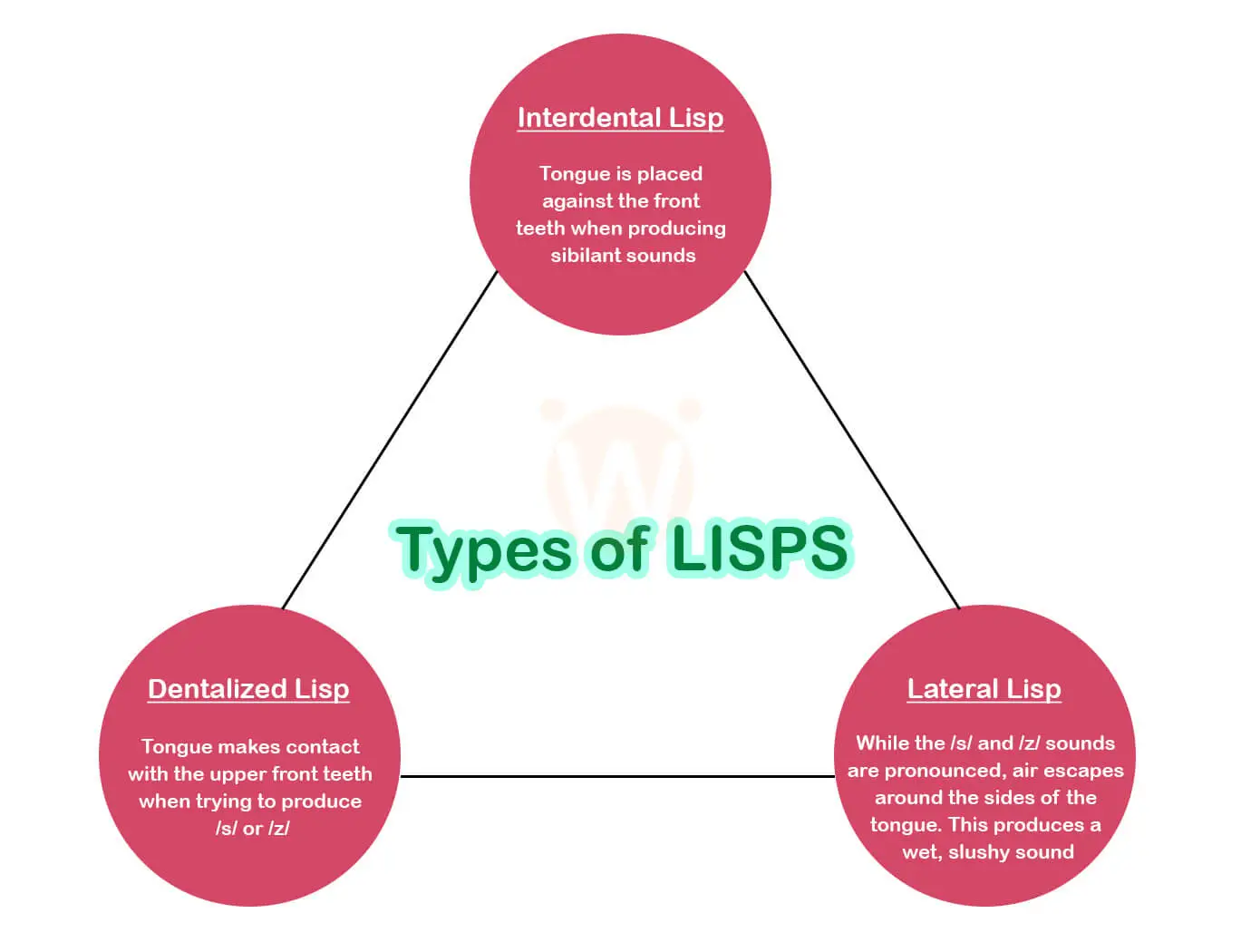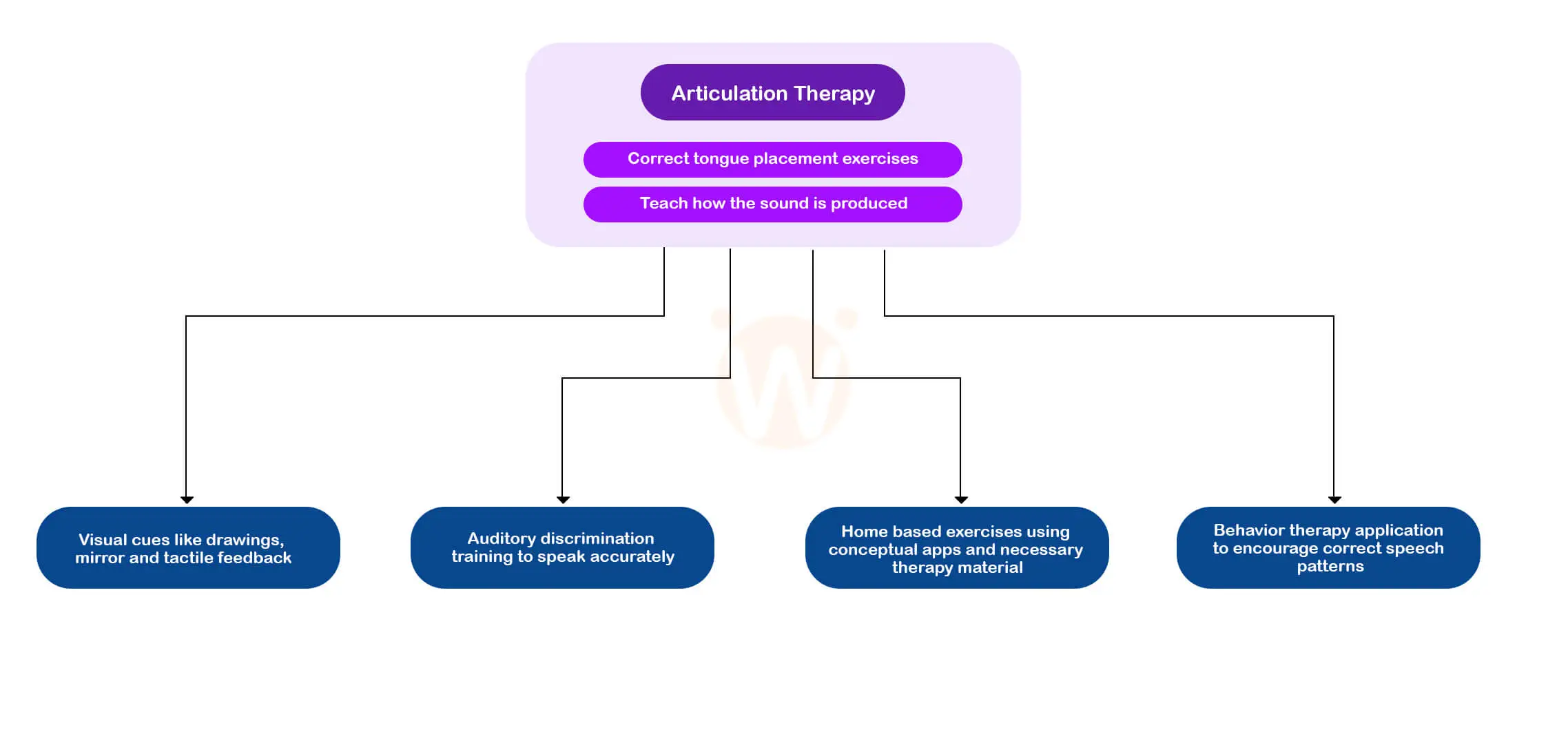What is Lisp: How Speech Therapy can help you deal with it
By Wellness Hub
Last Updated: October 19, 2023
When we talk, we use different parts of our mouth such as the tongue, teeth, palate, and lips to produce certain sounds. Usually when the sounds like “ss” or “zz” are produced, the tongue is placed at the front of our mouth, right behind the teeth. When air flows through such placement, these sounds are emitted. When someone has a Lisp, their tongue is placed improperly maybe touching the front of the teeth, going in between the teeth, or sticking out the tongue, instead of placing it behind the teeth. Now, it is understood that the sound produced is different from what they intend to.
This happens because their tongue naturally moves in such a way when they talk, that proper tongue placement is missed. Hence when they pronounce “sun”, it is heard as “thun”. Fortunately, speech therapy techniques help individuals with lisping overcome it.
Types of Lisps:

A lisp is a speech sound disorder characterized by difficulty in pronouncing one or more sibilant consonants, such as /s/, /z/, /sh/,/zh/, or sometimes other sounds as well. Lisping typically involves substituting the sibilant sound with a different sound. There are two common types of lisps:
Interdental lisp:
In an Interdental lisp, the tongue is placed against the front teeth when producing sibilant sounds, resulting in a sound like [θ] or [ð] instead of /s/ or /z/. An example of this can be, pronouncing “thun” instead of “sun.”
Dentalized lisp:
In a Dentalized lisp, the tongue makes contact with the upper front teeth when trying to produce /s/ or /z/, causing the sound to be distorted. This can lead to a sound that is similar to [s̪] or [z̪], but not quite as accurate as the intended sibilant.
Lateral Lisp:
In a Lateral lisp, while /s/ and /z/ sounds are pronounced, air escapes around the sides of the tongue. This causes a wet, slushy sound.
Sibilant consonants, also known as sibilants, are a group of speech sounds in which the tip, or blade, of the tongue, is brought near the roof of the mouth, pushing air past the tongue. This creates a hissing sound.
Some Examples of Lisping:
In English and many other languages, the primary sibilant consonants include:
- /s/ Voiceless Alveolar sibilant: It is heard in words like “snake,” “see,” and “sun.”
- /z/ Voiced Alveolar sibilant: It is found in words like “zebra,” “zero,” and “jazz.”
- /ʃ/ Voiceless post alveolar sibilant: It is heard in words like “shoe,” “she,” and “fish.”
- /ʒ/ Voiced post alveolar sibilant: It is found in words like “measure,” “vision,” and “pleasure.”
- /ʧ/ Voiceless post alveolar affricate: It is heard in words like “church,” “cheese,” and “teacher.”
- / d͡ʒ/ Voiced post alveolar affricate: It is found in words like “judge,” “giant,” and “badge.”
Sibilant sounds are important in many languages for distinguishing words from one another. For example, in English, the distinction between /s/ and /z/ can be crucial for differentiating words like “sink” and “think.”
Sibilants can be challenging for individuals with certain speech sound disorders or language backgrounds that don’t include these sounds. Speech therapy often addresses the correct production of sibilants to improve speech intelligibility. Additionally, sibilants play a significant role in the sound patterns of many languages, and variations in their pronunciation can contribute to regional accents and dialects
Why is Lisping caused?
Lisping can occur for a variety of reasons. The most common factors can be the following.
Developmental Factors
During the early stages of development, lisping can occur while a child learns to speak. While this is a normal phase, most children outgrow it. But for those who can’t, speech therapy helps.
Oral Structures
Structural issues such as tongue-tie or palate-related issues throw challenges in articulating /s/ and /z/ sounds properly.
Auditory and Motor Skills
For some individuals, it becomes difficult to perceive or imitate speech sounds correctly and produce them exactly as heard. This can also result in Lisping.
Environmental Factors
Just like other behaviors, Lisping can also be picked up as a behavior by kids who are natural observers.
Treatment and Therapies

Lisping can be treated successfully if identified and addressed early. Speech therapy helps individuals to overcome lisping. A Speech-language pathologist can assess the specific type and severity of the lisp and tailor therapy accordingly.
Speech therapy for Lisping
Lisps are common in children as they develop speech and language skills. Many children naturally outgrow lisping as they mature and their speech articulation abilities improve. However, if a lisp persists beyond a certain age (usually around 4-6 years old) or if it is causing communication difficulties, speech therapy with a speech-language pathologist (SLP) may be recommended.
Speech therapy for lisping typically involves exercises and techniques designed to correct the placement and articulation of the tongue and other speech organs involved in producing sibilant sounds. The specific approach and duration of therapy can vary depending on the individual’s age, the severity of the lisp, and other factors.
Lisping can be addressed using the following therapies:
Articulation Therapy
Using specific exercises and practices, the individuals are taught the correct way of placing the tongue while pronouncing the /s/ and /z/ sounds.
Visual and Tactile Cues
During articulation therapy, Speech therapists take the help of drawings or mirrors to let the individuals identify the proper placement of the tongue while pronouncing a certain sound. Tactile feedback can also be used for this purpose.
Auditory Discrimination Training
By discriminating between the target sound and the sound produced, an individual will learn to speak more accurately.
Home Practice
It is necessary to assign home-based exercises and practices for individuals to utilize the knowledge gained during the therapy sessions. Speech-language pathologists guide parents or caregivers in this regard. Conceptual Apps such as Speech Basics help people to continue therapy even after the sessions.
Behavioral Techniques:
As mentioned above, if Lisping was adopted as a behavior practice, techniques in behavior therapy could be employed to replace Lisp with correct speech patterns.
In the journey towards clearer and more confident speech, it’s crucial to recognize that lisping isn’t exclusive to children; adults, too, may encounter lisps or speech challenges stemming from diverse factors such as dental problems, hearing loss, neurological conditions, or environmental influences. For both young ones and grown-ups, the path to enhanced speech clarity and communication often involves the valuable support of speech therapy.
Taking action early is critical, and consulting a skilled speech-language pathologist can significantly impact refining speech skills and bolstering overall communication. Consider exploring the Wellness Hub, where online speech therapy for children is readily available, providing a convenient and effective solution for speech development in the comfort of your own space. Embrace the journey towards articulate and confident communication!
Frequently Asked Questions
1. What is a lisp meaning in speech?
A lisp is a speech disorder characterized by the mispronunciation of certain sounds, particularly “s” and “z.” Individuals with lisps may produce these sounds with a distortion, substitution, or omission, impacting overall intelligibility.
2. At what age should a lisp be a concern?
It’s common for young children to exhibit lisping as part of their normal speech development. However, if a lisp persists beyond the age of 4 or 5, it may be a cause for concern. Early intervention is crucial for effective treatment.
3. How long does lisp treatment take?
The duration of lisp treatment varies depending on factors such as the individual’s age, the severity of the lisp, and consistency with therapy exercises. Early intervention often yields faster results, but each person progresses at their own pace.
4. Can lisps be corrected in adults?
Yes, lisps can be corrected in adults through speech therapy. While it may take more time and effort compared to children, targeted exercises, practice, and guidance from a speech therapist can significantly improve speech clarity and reduce lisp tendencies.
5. Are there any home exercises to help with a lisp?
While professional guidance is essential, there are some home exercises that may complement speech therapy. Practicing specific tongue exercises, reading aloud, and using mirror feedback can be helpful. However, it’s crucial to consult with a speech therapist for personalized advice and structured intervention.
Book your Free Consultation Today
Parent/Caregiver Info:
Client’s Details:
* Error Message









